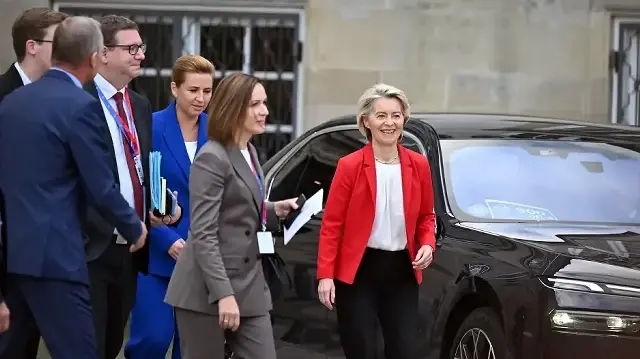Reklam yükleniyor...
Reklam yükleniyor...
OPINION - European leaders meet at Copenhagen: What does it reveal about Europe's security?

The European Political Community meeting that followed the informal EU summit produced little beyond symbolism, yet such symbolism retains political significance
- Defense remains largely outside the EU’s core mandate, where the Commission’s role is limited to industrial policy and defense financing. Implementation and division of labor between NATO, the EU and member states will be the real test
Reklam yükleniyor...
Reklam yükleniyor...
On Oct. 1-2, European leaders gathered in Copenhagen for two meetings: an informal summit of the European Council, and a European Political Community session. The latter, championed by French President Emmanuel Macron, brings together EU states, candidates like Ukraine and Moldova, and non-EU partners such as the UK and Norway.
Denmark, which currently holds the rotating EU presidency, hosted the meetings just days after Copenhagen had to shut down its main airport when drones hovered overhead, allegedly launched from a Russian-linked oil tanker later seized by the French navy.
Russia's ongoing war against Ukraine, suspected drone incursions over Poland and Romania, as well as repeated violations of Estonian airspace blamed on Russian fighter jets dominated the agenda. Faced with these challenges, EU leaders grappled with how to defend Europe's skies and how to deter Russia from escalating further.
- A costly weakness
The presence of suspected Russian drones over NATO and EU territory has become a major headache for European leaders. When 19 drones entered Polish airspace, NATO scrambled Dutch F-35s and Polish F-16s to shoot them down. It was a successful but costly operation. Each Sidewinder missile fired by the NATO jets carries a price tag of nearly half a million euros, whereas the drones destroyed are worth only a few thousand euros each. The economic imbalance is striking.
Ukraine has learned to handle such attacks with cheaper, more flexible means, but NATO's air defense posture remains heavily reliant on high-end assets, ill-suited to swarms of low-cost kamikaze drones. This is not only a financial problem but also a strategic vulnerability that Russia is all too eager to exploit.
- Building a layered defense
What Europe needs is a layered air defense, especially on NATO's eastern flank. The first line should be cheap, mobile tools like jammers, lasers, electronic warfare and drones to intercept kamikaze UAVs. The second should rely on medium-range systems such as Germany's IRIS-T SLM or the Norwegian-American NASAMS for larger drones and short-range missiles. The top tier must counter ballistic and hypersonic threats with proven systems like Patriot PAC-3, THAAD or Europe’s SAMP/T.
Moreover, it is not enough to build such a system. Europe must also train realistically, including large-scale exercises against swarms of drones, a scenario NATO allies still rarely practice. Without a comprehensive and cost-effective air defense system, Europe risks depleting both its arsenals and its budgets, dealing with Russia on Moscow's terms.
- Von der Leyen’s ‘drone wall’
As a response, European Commission President Ursula von der Leyen proposed a "drone wall": a continent-wide network of detection, tracking and interception systems interoperable across EU states. Acoustic sensors, radars and electronic countermeasures would, in her vision, form a shared shield against the drone threat.
The plan sounds compelling, and, despite initial hesitation, it received broad support from member states. Still, defense remains largely outside the EU's core mandate, where the commission’s role is limited to industrial policy and selected forms of defense financing, such as the recently adopted SAFE instrument. Implementation and division of labor between NATO, the EU and member states will be the real test.
- NATO must respond with measured yet robust action
In addition to boosting its air defense architecture, NATO may find it important to underline that the security of allied airspace remains a non-negotiable priority. Poland and Sweden have already declared their readiness to intercept any Russian aircraft intruding on their airspace. Yet, the Baltic Air Policing mission continues to operate under peacetime parameters, where the use of force is limited to strictly defensive circumstances. A careful review of this framework could strengthen both credibility and reassurance for member states.
At the same time, European allies would benefit from further developing the capacity to address not only incoming threats but also the systems that enable them. In practice, this means ensuring that long-range defensive and strike capabilities are sufficiently credible to discourage potential aggression. By combining layered air defenses with such measures, Europe can move toward a more balanced and comprehensive deterrence strategy, one that prioritizes stability and preparedness.
- The struggle to counter Russia goes on
The European Political Community meeting that followed the informal EU summit produced little beyond symbolism, yet such symbolism retains political significance. The presence of Moldovan President Maia Sandu and Ukraine’s President Volodymyr Zelenskyy was a stark reminder of what is at stake: resisting Russia’s revisionist and aggressive agenda. Yet time is running out. Every drone that crosses European skies is not only a test of defenses but also of political will. Further delay would undermine Europe’s credibility, urgent and coordinated action is required.
*The author is a Policy Analyst with the European Policy Centre in Brussels
Reklam yükleniyor...
Reklam yükleniyor...







Comments you share on our site are a valuable resource for other users. Please be respectful of different opinions and other users. Avoid using rude, aggressive, derogatory, or discriminatory language.